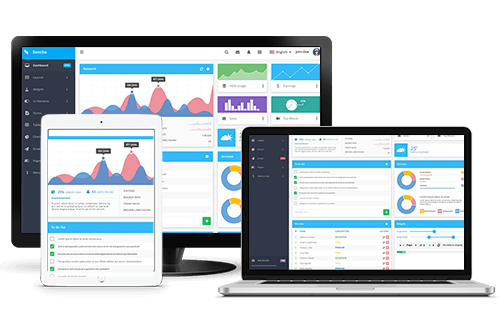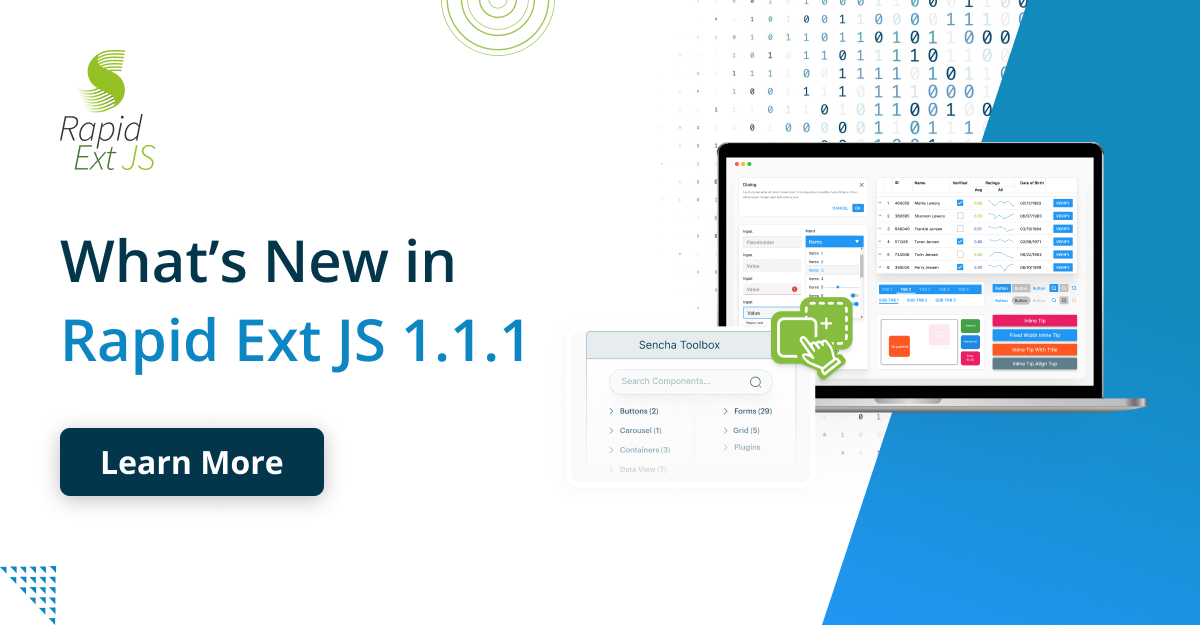Top 8 Reasons Why Enterprises Prefer Sencha Ext JS over Angular

Although comparing Angular and Sencha Ext JS is like comparing apples and oranges, it is surprising how frequently the comparison is made. Ext JS 6 is a JavaScript framework well suited to create enterprise apps that scale; Angular is not really designed with enterprise developers in mind. In this blog, we will outline 8 of the most common reasons that enterprises choose Ext JS over Angular.
Reason #1: Components, Components, Components!
Ext JS 6 has possibly the largest component library when compared to any other js frameworks in the market today. Ext JS 6 contains components that are optimized for both desktop and mobile devices; using a single codebase, developers can write an application for desktop, tablet, or smartphone devices. Both desktop and mobile apps can be themed to personalize the application to the company’s brand identity. Additionally, mobile apps can be themed to achieve an iOS, Android, and BlackBerry look and feel. The components in Ext JS are part of a single library, so each component is designed to work with the others.
In comparison, Angular does not come with a component library. Angular developers have to find their components outside of the framework.
Reason #2: Ext JS Has Been Battle-Tested Since 2007
Sencha was launched as a company in 2007, with Ext JS as its first product. Since then, Ext JS has been used in the production of thousands of apps. Ext JS has evolved over the years and through many versions to become a stable framework designed to help developers deliver sophisticated, cross-platform web applications from a single framework. Through this evolution, we’ve maintained our commitment to ensuring the long-term success of our customers. It’s because of that commitment that we continue to support older versions of the platform including Ext JS 3.x and above. We also offer training and migration services to customers who want to migrate from older versions of the platform to more current versions and take advantage of the latest features. We also ensured that the migration from Ext JS 5.x to 6 would be virtually seamless.
For Angular customers, the transition to Angular 2.0 will not nearly be as smooth. As many AngularJS developers are painfully aware, Angular 2.0 is a complete re-write. In fact, as of today, the release date of Angular 2.0 is still to be announced. Unfortunately for Angular developers, migrating an app from AngularJS to Angular 2.0 means re-writing their entire app.
Reason #3: A Robust Framework for Building Apps vs Building One’s Own Framework
Ext JS 6 is a framework designed to be used out of the box to create apps. Ext JS 6 comes with an extensive component library, in addition to an MVC/MVVM core; when using Ext JS, developers don’t need to spend valuable time and effort creating or sourcing components.
Angular, however, is a toolset for developers to build their own framework; not for building their own apps. Because Angular is an MVW framework, microframework developers can use Angular as a starting point to create their own framework.
Reason #4: Clearly-Defined Legacy Browser Compatibility By Default
Given Sencha’s commitment to the enterprise, we are committed to supporting the browsers that enterprises use. As of today, companies expect support for Internet Explorer because Microsoft browsers are still common within enterprises. To meet this need, Ext JS 6 has committed to supporting Internet Explorer 8+.
Unfortunately, Angular 2.0 browser support has not yet been clarified. It’s likely that Angular 2.0 out of the box may only target evergreen browsers. Much to the disappointment of AngularJS users, AngularJS 1.3 dropped support for Internet Explorer 8 in order to keep adding features. At Sencha, given our enterprise client base, we avoid making drastic compatibility changes in minor releases.
Because applications that use Ext JS 6 frequently don’t need other libraries, it is much easier to state the browser requirements for those apps. Angular 2.0 apps frequently use multiple libraries which means the browser requirements have to be the newest of all of the libraries used by the app. A developer has to keep track of browser requirements of each library used to be able to state the browser requirements of their app.
Reason #5: Integrated Tools Created With a Clear Vision and Purpose
Ext JS 6 was created with a clear vision and purpose to allow developers to create beautiful web applications that scale. All the components and parts of the framework are designed to work cohesively. Additionally, Sencha has several tools including Sencha Cmd, IDE plugins, and Sencha Inspector that developers can use to speed up their application development.
Angular, however, is a microframework that only provides a small part of the solution for creating applications. Developers frequently need to stitch together other microframeworks and component libraries in order to create a complete application. Because these microframeworks may not be designed to work specifically with Angular, various conflicts and problems can occur. Further, Angular has substantially fewer tools available to assist with application development.
Reason #6: No Need to Learn TypeScript or other tools and component libraries with Ext JS 6
Ext JS 6 is a JavaScript framework which is perfect for writing complex enterprise apps that scale. In order to use Ext JS, you need to have experience with object-orientated programming and some JavaScript. There is no need to learn how to use and integrate disparate tools and languages to get started.
Angular 2 developers will now have to learn TypeScript, an obscure programming language created by Microsoft, to use Angular 2.0. In order to use TypeScript, developers need to be familiar with ECMAScript 6 syntax which has not even been implemented in browsers today. Sencha does believe TypeScript, as a language, holds promise. However, until it is widely adopted, there will be skill differences between team members for the obscure language that will make it harder to understand each other’s code.
Additionally, Angular developers need to learn a host of other tools and component technologies. Because Angular developers need to use third party component libraries, developers need to have a firm grip on Twitter Bootstrap, Kendo UI, jQuery, Ionic, Material Lite and many more component libraries. Because there is weak mobile and desktop component integration, developers typically need to learn totally different component libraries and create separate mobile and desktop applications. Additionally, developers needs to learn other tools like batarang, karma, grunt, gulp, and many others. Quite often, these component libraries and tools weren’t designed with Angular in mind, which can often lead to a cluttered and awkward integration.
Reason #7: Excellent Design Tools
Sencha has a standardized set of components and provides an excellent set of design tools. In particular, Sencha Architect is a perfect tool to create clickable prototypes. Additionally, Ext JS Stencils can be used to create wireframes and mockups that correctly reflect the look and feel of components.
Because Angular does not include a component library, it is up to the designer to create mockups that accurately reflect the components.
Reason #8: Awesome Support and Training Options From the Creators of the Framework
Sencha has excellent support and training teams. Additionally, Sencha has a professional services team that can assist with a variety of enterprise development needs.
For Angular, like most Google tools, if you are getting the software for free, you are a user, not a customer. Support, training, and other services aren’t provided by Google for Angular products.
Ready to get started?
We strongly believe that if you are building complex, enterprise class web applications there is no better choice than Ext JS. We provide the robust set of features, services, training and support to help you succeed. Try Ext JS free for 30 days and let us know what you think.
Download Ext JS
Watch the Ext JS 6 webinar
See Ext JS examples

The Sencha team is excited to announce the latest Sencha Rapid Ext JS 1.1.1 release…

React is perhaps the most widely used web app-building framework right now. Many developers also…

React’s everywhere. If you’ve built a web app lately, chances are you’ve already used it.…










